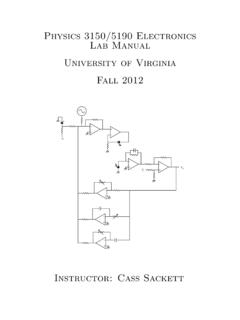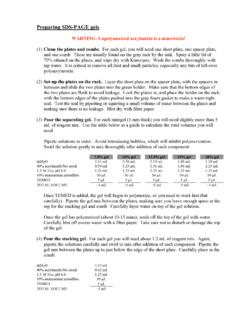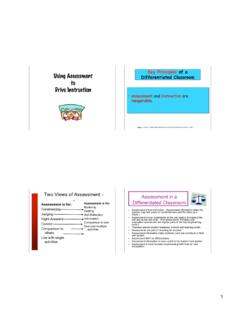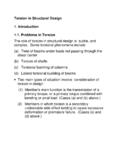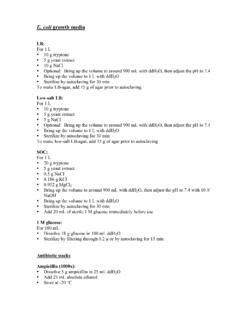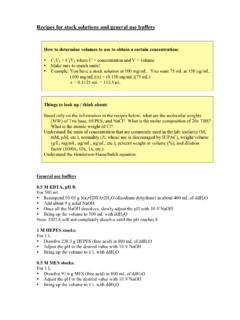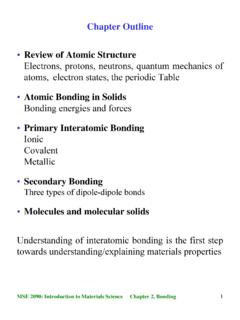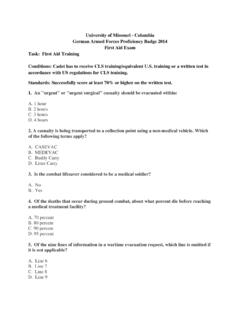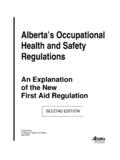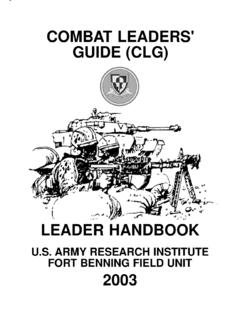Transcription of Daniel Ricciardi MD - University of Virginia
1 Daniel Ricciardi MD Why is this important? Ballistics and GSW basics Anatomy and physiology of shock Purpose and contents of IFAK Practical use of IFAK I am not a military physician Based on expert opinions Not intended to be anything more than basics Use it or lose it Further education recommended Terminal ballistics E= 1/2mv2 This equation describes the energy or wounding potential for a projectile on tissues. Thus doubling the mass of a projectile doubles the energy of the projectile but doubling the velocity quadruples the energy of the projectile. 3 factors determine the wounding potential of a projectile. Frontal Area Velocity Distance Frontal area refers to the area of the projectile where it strikes the tissue. Frontal area is effected by expansion, tumbling, and fragmentation. Bullet fragmentation occurs either spontaneously or when bone is struck and produces secondary missiles.
2 Fragmentation can occur with pistol or rifle rounds but is more common with high velocity rifle rounds. Of all the factors listed fragmentation is responsible for the greatest wounding potential. Higher rate of morbidity and mortality are associated with higher velocity rounds. Most people shot with a pistol survive and most people shot with a rifle do not. Mostly relates to velocity but contact/extreme close range GSW s can have surface burns associated The morbidity of the wound relates to the tissue through which the bullet passes. There are two types of wound tracts temporary and permanent. The temporary wound cavity results from an ultrasonic shock waves which deposits energy and CAN disrupt tissue. Also known as cavitation. The amount of damage sustained depends on the tissue effected. Muscle, lung, and bone are resistant to the stretching forces of cavitation, liver is not. By way of comparison, lithotripsy treatment of kidney stones involves U/S waves 2-3 times stronger than cavitation with no significant injury.
3 In order of importance, Life threatening Brain and brainstem Heart and aorta Other great vessels of the chest Lung, specifically tension pneumo Abdominal Peripheral arterial Philosophy of use; an IFAK is a kit which contains everything needed to provide immediate life saving treatment of battlefield injuries. It is NOT a basic FAK nor is it intended to provide definitive care. When someone is injured, ideally the patient s IFAK is used to render immediate aid. Airway compromise Tension pneumothorax Severe bleeding Airway compromise. Most commonly ,a diminished LOC will result in airway compromise from the tongue falling back into the posterior oropharynx. A nasal pharyngeal airway and proper head positioning will relieve this. Less commonly, trauma to the face or neck will result in airway obstruction due to actual ballistic damage to the trachea or massive bleeding into the airway. Few options exist for the layperson to provide care since surgical airway techniques will be needed.
4 The anatomy of the chest requires surface tension between the lung and the pleura to expand the lung when the chest expands and the diaphragm drops. Air introduced into the pleural space will prevent this from happening and result in a pneumothorax or collapsed lung. A puncture wound to the chest can act as a one way valve allowing air to enter but none to leave. When this occurs, air will build up on one side of the chest eventually exerting pressure on the heart and resulting in shock and death. Insert a 14 g angiocath into the 3rd intercostal space to relieve pressure A chest wound large enough so that air can freely enter and exit on inspiration and expiration. This results in complete collapse of one lung and ventilatory capacity cut in half. treatment involves using a chest seal which is a one way flutter valve. One can use a commercial product or improvise a seal using tape and any occlusive material.
5 Shock is defined as a failure to deliver adequate oxygen to tissues. In the case of blood loss this occurs both due to loss of blood volume and hemoglobin which carries oxygen in the blood. Adults have approximately 5 liters of blood. As blood loss increases, physiologic changes will become more prominent and more severe. Loss of <15% Symptoms Normal BP Normal heart rate Anxiety can be variable 15-30% volume loss (750-1500 ml) Symptoms and signs Elevated heart rate (>100 BPM) Normal blood pressure Increased respirations Anxious or restless Mental status maintained 30-40% volume loss (1500-2000 ml) Systolic BP begins to fall but can be variable Pronounced heart rate increase >120 BPM Pronounced increase in respiration >30 RPM Confusion or agitation Sweating and cool skin Very sluggish capillary refill >40% volume loss (>2000 ml) Symptoms and signs Marked decrease in systolic BP Marked increase in heart rate >140 BPM Marked rapid respirations Lethargy, loss of consciousness Cardiac arrest In emergency medicine, the golden hour refers to a time period lasting from a few minutes to several hours following traumatic injury being sustained by a casualty, during which there is the highest likelihood that prompt medical treatment will prevent death.
6 Prevention of shock requires rapid decisive action to stop blood loss. Typically, arterial blood loss will result in the most rapid onset of shock. Severe blood loss is the most common preventable cause of death in GSW s. Arteries carry oxygen rich blood to tissues and are high pressure systems Veins carry oxygen-poor, carbon-dioxide rich blood back to the heart to be pumped into the lungs. The venous system is low pressure but high capacitance. ABC s Airway Breathing Circulation Radial- thumb side of wrist just below and to the middle of bony projection Brachial- arm in surrender position thumb next to bone Femoral- just below and medial to iliac spine Dorsalis pedis- top of foot; less useful Carotid- lateral to Adam s apple below jaw We will focus on treatment of rapid blood loss today since this is the most common and easily treated cause of preventable death. Specifically we will look at care of extremity blood loss because options are limited for treatment of severe bleeding from the head and neck, chest, and abdomen.
7 The treatment of any ongoing blood loss involves some form of pressure at the source of blood loss. When blood is not moving there is a strong tendency to clot and these clots are what stops the bleeding. Therefore, after bleeding stops utmost care must be exerted to prevent disruption of the clot and further bleeding. Some exposure of the wound is desirable and best achieved by cutting away clothing and gear. If bleeding is a steady ooze, appears to be dark red and is NOT pulsatile only direct pressure will likely be needed. You are at the plinking range with some friends when you here some you hear screaming from the rifle range. You grab your IFAK and run over to see what happened. You arrive to find a man in his 40 s clutching his right thigh as blood flows past his fingers and starts to spread on the ground. What do you do? Assessment: Airway and Breathing appear to be intact he is able to speak and tell you his name.
8 The wound appears to be mid-medial thigh. The blood is pumping between his fingers and appears to be bright red. Insure your own safety Activate EMS Consider transport times and your location when deciding whether to wait for EMS or scoop and scoot AFTER minimal patient stabilization A calm demeanor on the part of the person rendering aid is instrumental in reassuring the patient and achieving a good outcome. A panicky anxious patient has an increased heart rate and blood pressure which accelerates blood loss and hastens shock. The vast majority of extremity hemorrhage caused by penetrating trauma can be controlled by direct pressure and elevation. Hemorrhage control by direct pressure is best accomplished by applying firm circumferential pressure around the limb trapping the injured tissue against the bone and elevating the limb until bleeding is completely stopped. 2 main types exist Israeli bandage H-type bandage Both types are effective and can be applied by the patient.
9 (yes, this takes practice!) The use of tourniquets used to be controversial. It was thought that indiscriminate use would lead to tissue damage from limb ischemia and amputation. In fact, tourniquets are routinely used during orthopedic surgeries and routinely left on for up to 3 hours with no ill effects. Also, the recent wars have taught us that widespread tourniquet use saves lives. The patient must have a tourniquet in place before the onset of shock. Patients with a tourniquet placed in the absence of shock had a 90% survival rate versus a 10% survival rate in those whose tourniquet was placed after development of shock. Ideally, the patient will be able to place his own tourniquet to avoid needless delay. In order to be effective a tourniquet must be applied properly. It is applied at least 3-4 inches above the wound or above the nearest joint. They must be left in place throughout transport and only removed at the hospital.
10 Improper location of application Insufficient pressure applied Removing TQ to check if it s still bleeding Powder, bean bags , or gauze which promotes blood clotting. Several products exist, Quik clot, Celox, Hemcon Early products caused significant heat production and were inconvenient due to granular formulation After clinical trials, Quik Clot Combat Gauze was chosen for US Army IFAK s. This product offers the advantages of easy application and no heat generation. The Z-folded gauze is easier to apply to deep wounds. Other products Celox Gauze, ChitoGauze also reported to be excellent choices Primarily used for wounds not amenable to tourniquet use. Very proximal extremity wounds with arterial bleeding. Possibly large abdominal wounds with brisk bleeding. It is unlikely the wound will be large enough to pack Neck or scalp wounds in non-compressible areas. Minimalist kit- cheap TQ, compression dressing GTG kit- trauma shears, CAT, compression bandage, Hemostatic gauze Medic Level kit- Above plus chest seal, airway, needle decompression device, roll of gauze plus the skills to use these!
